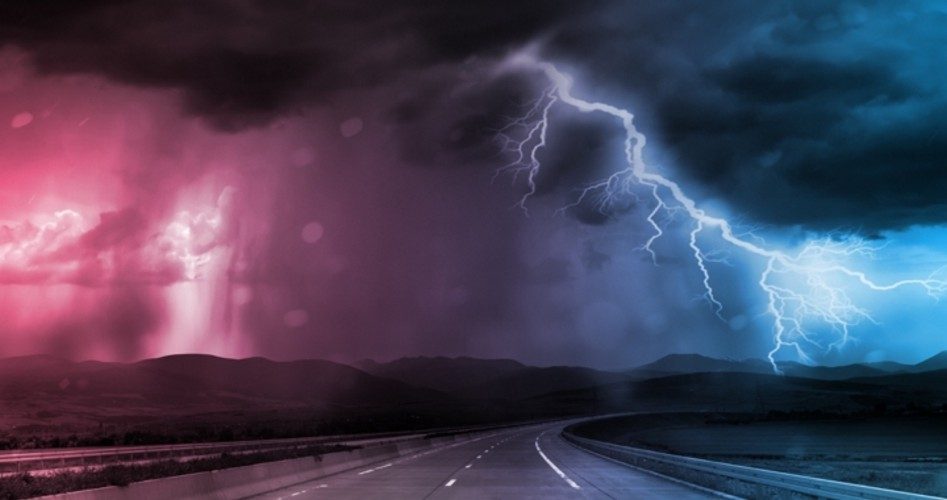
Greece and California are literally burning up due to high temperatures and parched dry land due to drought. Record high temperatures have been recorded in Japan, Africa, Europe and the United States, causing hundreds of deaths. Flooding from sea level rise threatens to submerge more than 300,000 coastal homes in the next thirty years. These are some of the “sure signs” that climate change, formerly known as global warming, is upon us now. It’s happening right before our eyes.
Except, thus far in 2018, extreme weather events have been less numerous and severe than in most other years. Even with all the recently hyped weather events currently occurring, Dr. Roger Pielke Jr. shows us that global weather losses as a percentage of Gross Domestic Product (GDP) are on pace for record lows in 2018. Of course, being that we’re only seven full months in to the year, those numbers can change. But for now, 2018 is on pace for record low spending on weather disasters.
Pielke, a mathematician and the son of renowned atmospheric scientist Roger Pielke Sr., believes that a direct correlation exists between the severity of weather disasters and the amount of money spent on them. “I have updated graph of weather disasters as proportion global GDP (2018 annualized). Through seven months of 2018 weather disasters as % GDP are on record (low) pace (crosses fingers).” Pielke tweeted on Monday.
Because climate alarmists tell us that, with climate change, instances of extreme weather will definitely increase, the amount of GDP spent on such weather disasters is one good way to tell if the alarmists are correct. Since 1990, the amount of GDP spent on weather disasters is trending downwards. That’s bad news for the climate alarmists.
Climate alarmists face a serious challenge. Their predictions and models show disastrous times decades ahead but in order to keep the public both engaged in and afraid of climate change, they are forced to sensationalize current weather events to a, sometimes, ridiculous extent. Every hurricane, every wildfire, every heatwave must be dramatized and exaggerated in an attempt to show a public that is rapidly tuning out their prophesies of doom that catastrophe is still on its way. In fact, in breathless tones, they claim it’s already here.
So, when extremely cold weather hits and climate realists wonder if anthropogenic global warming is all that serious, climate alarmists condescendingly point out that, “Weather is not the same as climate. You cannot infer long term climate trends from individual weather events.”
But the hypocrisy from climate alarmists is blatant and annoying. If a tree catches on fire in a forest, a heatwave occurs in summertime, or a tropical storm forms in the Atlantic Ocean, every Chicken Little climate journalist in the world tells us that the sky is falling. Shouldn’t the same “weather is not the same as climate” concept apply?
And not only is the sky falling but it’s all our fault. This is why we get headlines such as this one from the Independent: “Carr fire: California wildfires will only get worse in the future because of climate change, experts say.” Or this one from The Guardian: “Flooding from sea level rise threatens over 300,000 U.S. coastal homes — study.” Or this one from Real Clear Energy: “Record summer heat: Can we finally blame climate change?” The headlines claim that current weather conditions hint of future catastrophes. And the stories themselves imply that we should feel guilty about it.
Thus far this year, tornado activity is far below normal, the hurricane season is expected to be much quieter than usual, and Greenland has added 600 billion tons of ice. Does human activity get credit for causing these weather events as well? If so, well done, mankind!
Climate change is the perfect issue for globalist to plant their one-world-government flag upon. It is both unproveable and at the same time unassailable. Its predictions of doom are far enough in the future that the goalposts can always be moved to reset whatever narrative the alarmists wish to create. It is nebulous enough that it cannot be truly contained within national borders — only a one-world entity can address a problem so big.
But Pielke shows us that those headlines of current climate disaster don’t show up in the bottom line. If extreme weather is on the increase as the climate charlatans imply, shouldn’t the money we spend to address these increasingly severe disasters reflect that?
Photo: andreusK/iStock/Getty Images Plus




